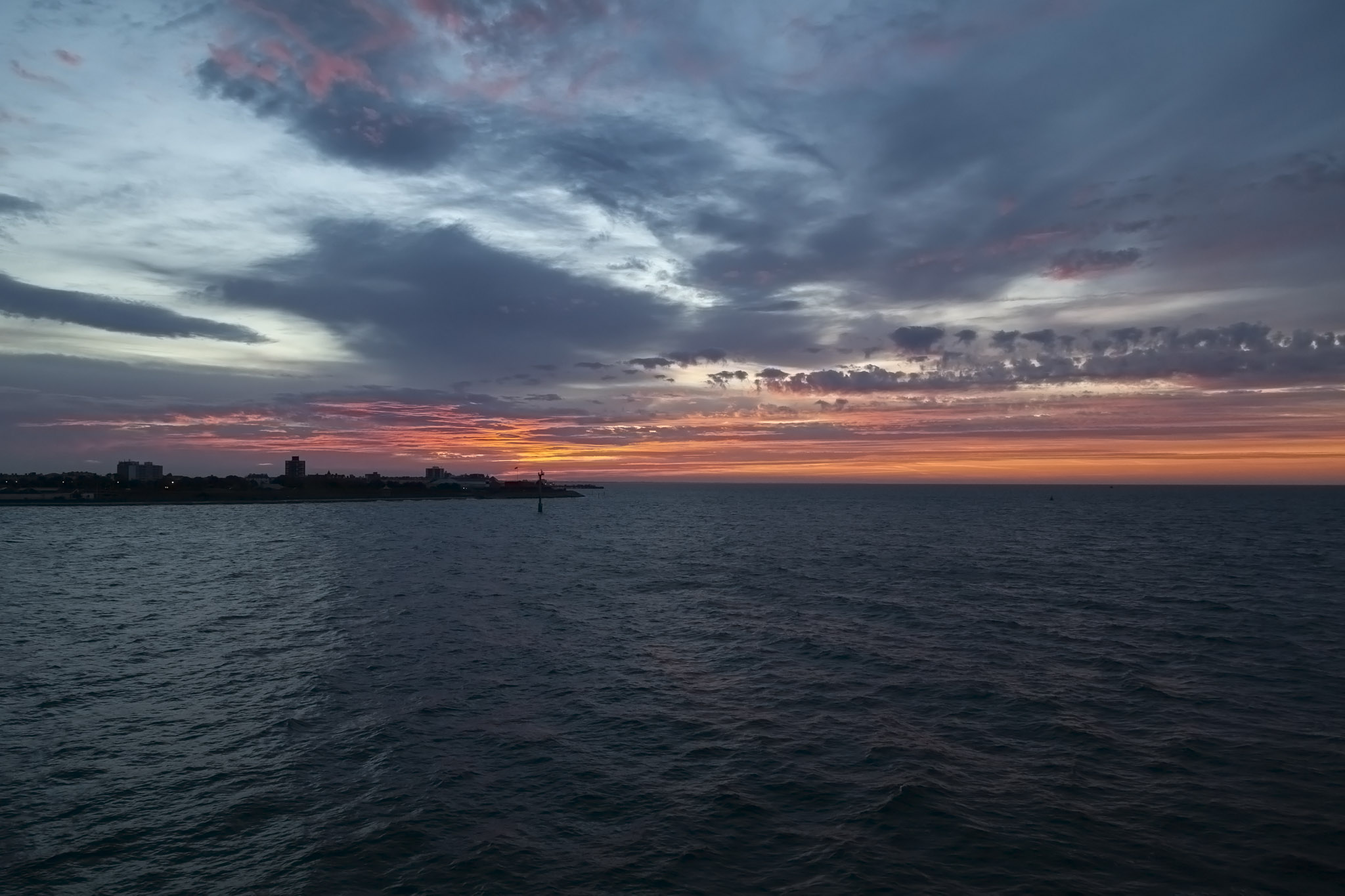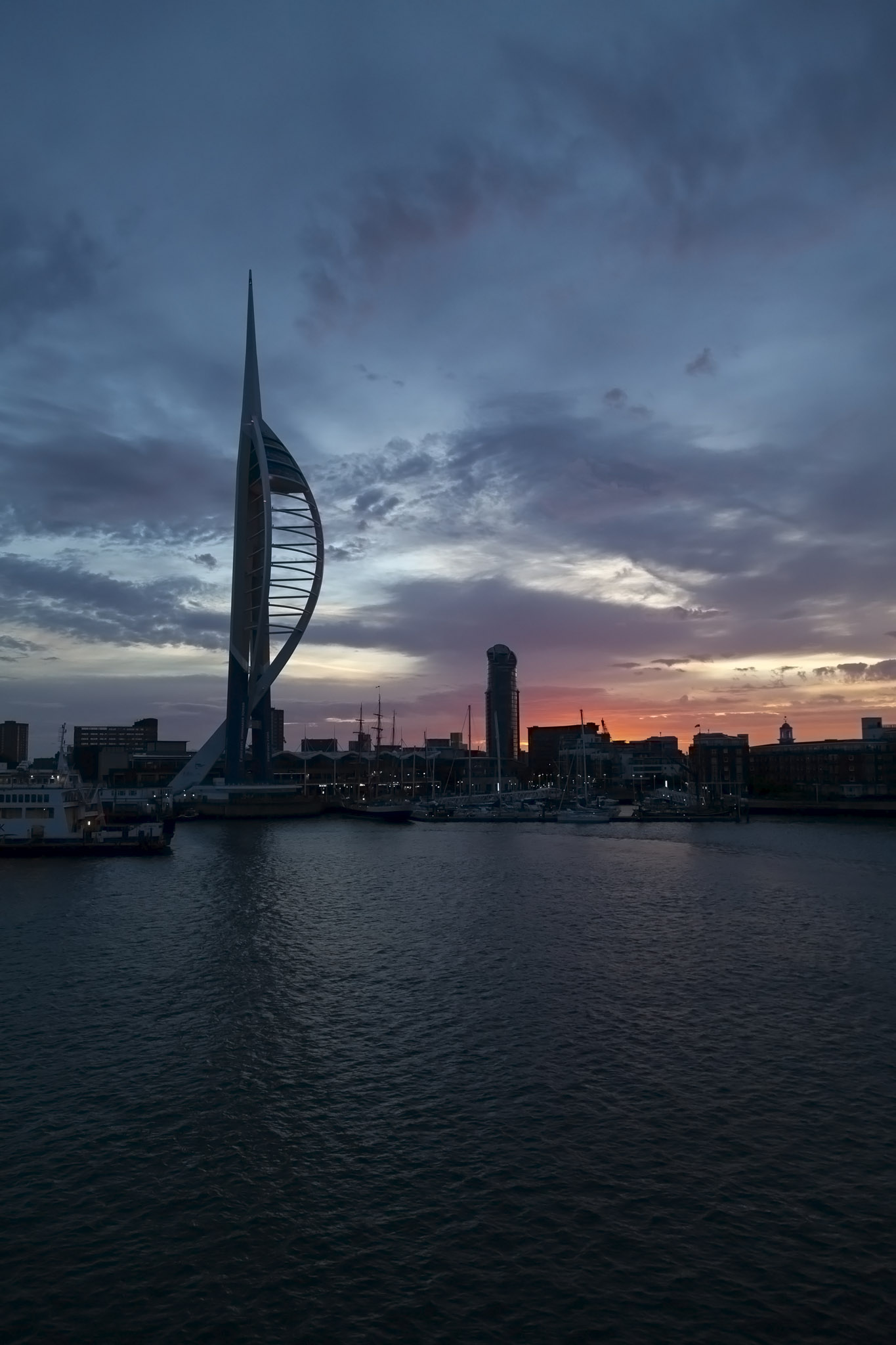Our overnight gala cruise aboard the CMV Astoria came to an end early in the morning as the ship approached Portsmouth Harbour where it was due to dock at the International Port at 07:00. This was also the time we were due out of our cabins (rather early, we thought) and with breakfast starting at 06:30 and us not wishing to take our luggage to the buffet area if we could avoid it we set our alarm nice and early so that we’d have a chance to get some food and get back to the cabin to pick our stuff up before disembarkation.
That was the plan right up until we opened the curtain in our room and saw that not only were we still a little way off the Southsea coastline but the sun hadn’t risen yet and was in the process of painting the eastern horizon with some gorgeous dawn colours against which one of the Solent forts was nicely silhouetted.
Breakfast was postponed and we headed out to the promenade deck of Astoria instead to enjoy nature’s accompaniment to our slow progression into our home port.
The first thing we passed along Portsmouth’s seafront is Southsea’s funfair, Clarence Pier (not much of a pier to be honest), which dates back to 1861 although its present form is a reconstruction following damage from German bombing raids in World War II. The most prominent visible structure in the low light of the early morning was the Solent Wheel which comes and goes with the seasons, it seems, and is considerably smaller than the original design called for.
Before we reached the major icon of the Portsmouth skyline (and another structure considerably smaller than the original design called for (I’m sensing a pattern)), the Spinnaker Tower, we then cruised past Spice Island (as it’s known locally for seedy, historical reasons), easily identified by the fortifications that protected it and the city and closed it off from the rest of Portsmouth, and from where the official name, Portsmouth Point, derives and from the abbreviation of which in ship’s logbooks – “Po’m P.” – is one explanation for the city’s nickname. The Square Tower and Round Tower are fairly easy to spot in the photographs below and the church in silhouette is the Garrison church, another victim of wartime raids in the area.
If you’re ever on a cruise out of Southampton you’ll probably be able to see the highly recognisable landmark of Portsmouth, the 170 metres-high Spinnaker Tower, from quite some distance away, and rounding Spice Island took Astoria right past it. The Spinnaker Tower, as its name implies, is designed to resemble the sail of a ship and is located in the waterfront outlet retail centre of Gunwharf Quays. We’ve been up the tower several times and it and Gunwharf are great and popular places to visit if you ever hit Portsmouth yourself. Listen to me sounding like a regular travel blogger there and recommending places!
The final stretch of water in through Portsmouth Harbour and towards the cruise port took Astoria past the headquarters for the Americas Cup yacht-building team, the Historic Dockyard, and the Royal Navy Dockyard (technically, Her Majesty’s Naval Base, Portsmouth but I don’t know anyone who calls it that).
The historic dockyard houses the famous maritime vessels you’re probably well aware of: HMS Victory, HMS Warrior, and Mary Rose. Again, trying not to sound too much like a cheesy tourist guide to my own city here but really worth a visit if you come down.
Friends of ours were married on HMS Warrior, the first armour-plated, iron-hulled warship. She’s a lovely ship to walk around.
HMS Victory is the world’s oldest naval ship still in commission, is the flagship of the First Sea Lord, and was Lord Nelson’s flagship during the Battle of Trafalgar. The upper masts and much of the rigging has currently been removed for repair hence her squat appearance but it’s still a very worthwhile visit if you get the chance just to see the spot where Nelson was killed on the deck.
The first English and oldest surviving dry dock in the world was built at Portsmouth in 1495 under the orders of the Tudor king Henry VII. These days the naval base, the oldest in the Royal Navy, serves as home to two thirds of its surface fleet. Cruising quietly past in the early hours of the morning we were strangely impressed by the number and variety of ships docked – it’s just something we’ve never really been that aware of living in the city all our lives – and were only slightly disappointed that the aircraft carrier HMS Queen Elizabeth was out at sea on trials.
HMS Tyne is a River-class offshore patrol vessel that had a fairly short lifespan before being decommissioned early in 2018 only to be recommissioned a few months later when it was realised that the political implications of this country’s idiotic sprint into economic oblivion thanks to the racists, morons, and racist morons who voted for and are carrying through with Brexit despite all common sense might require some form of dick-waving to protect our microscopic fishing industry. You don’t want an occasional political rant when you’re reading a travel account? There’s always somewhere else dull to read.
HMS Dragon is pretty easy to spot if she’s docked in the Portsmouth Naval Base on account of her distinctive Welsh red dragon prow decorations; she is the only Royal Navy ship so decorated. Dragon is a Type-45 (Daring-class) air-defence destroyer.
One of Dragon’s sister ships is HMS Defender. As this is a travel-related site these days with an emphasis on cruising it’s worth noting that HMS Defender escorted Cunard’s Queen Mary 2 through the Gulf of Oman in 2016. Not a cruise ship or line we’ve experienced yet nor a part of the world we’ve cruised through, either, but we’d quite like to, especially if you can get a warship escort as well.
HMS Westminster is a Type 23 frigate. If you’ve ever seen the James Bond movie Tomorrow Never Dies then you’ll have seen parts of HMS Westminster as she was used to film the interior shots of the vessels HMS Chester, HMS Devonshire, and HMS Bedford.
Another Type 23 frigate docked in Portsmouth Harbour as we cruised past was HMS St Albans. The cruiseferry GNV Atlas – in 2002 operating with P&O Ferries as the Pride of Portsmouth – crashed into HMS St Albans due to gale force winds before it had entered operational service, causing damage to the gun deck and bridge.
Currently awaiting disposal following decommissioning, the final naval ship we spotted on our approach to the port was RFA Gold Rover, a Royal Fleet Auxiliary Rover-class tanker. In its first year of commission, 1974, Gold Rover assisted with evacuation duties during the invasion of Cyprus by Turkish forces.
Some miscellaneous photos of the various warships around the naval dockyard of Portsmouth:
Finally, we approached the port itself, grabbed our bags from our room, left the keys in the room (a CMV thing: you leave the keys in the room on disembarkation otherwise you’re charged for them), had some breakfast in the buffet (fairly standard fare although the ability to have omelettes and fried eggs prepared for you at a station while you waited was quite a nice touch), then waited to be allowed to disembark. That took a surprisingly long time considering this had been an overnight cruise from Poole to Portsmouth (so there couldn’t have been customs to clear you wouldn’t have thought) but eventually we were called deck-by-deck to depart Astoria and our deck was called first. A ten minute walk from the port saw us arriving home.
I’m biased, of course, but Portsmouth is a fantastic port to cruise into because of all the incredible, history-rich sights you pass on the way in. To do so while the sun has just started lighting up the horizon is an incredible experience and one you shouldn’t miss if you ever have the chance.




























































